My socks, damp from the washer, hanging over the spark-shield to dry near the fire.
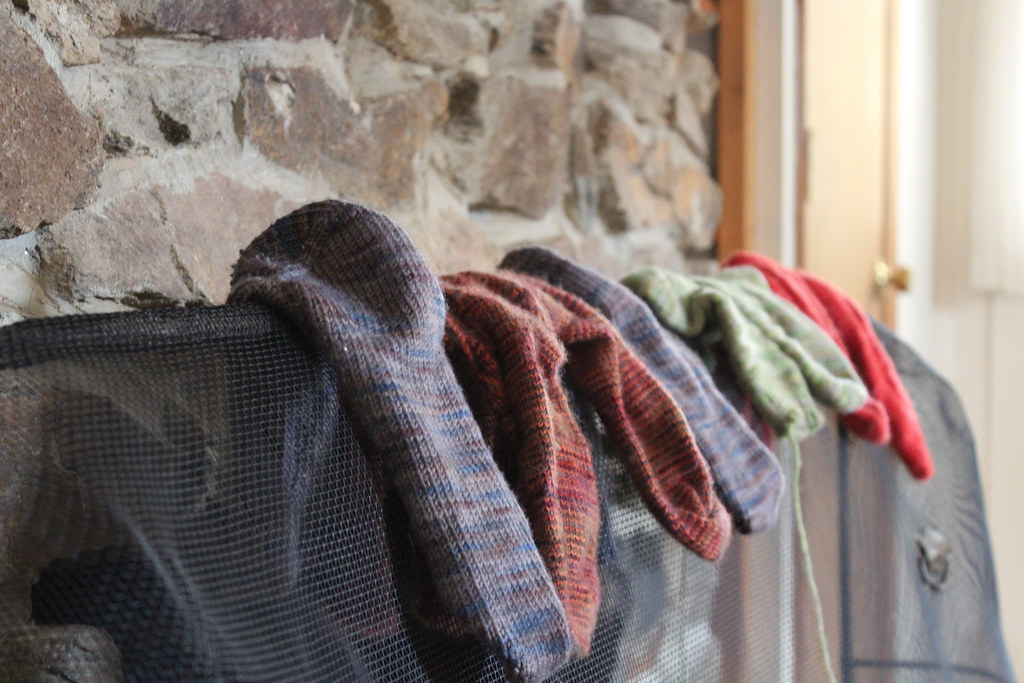 |
| Socks drying. |
I caught a picture of them the next morning, as we were leaving the farm.
As I mentioned before, Michael and I spent New Year’s up at the Farm. We invited a few friends, including the friend I’ve had the longest, my best-friend Becca. She was one of the bridesmaids at out wedding, and I’ve known her since I was 9 years old.
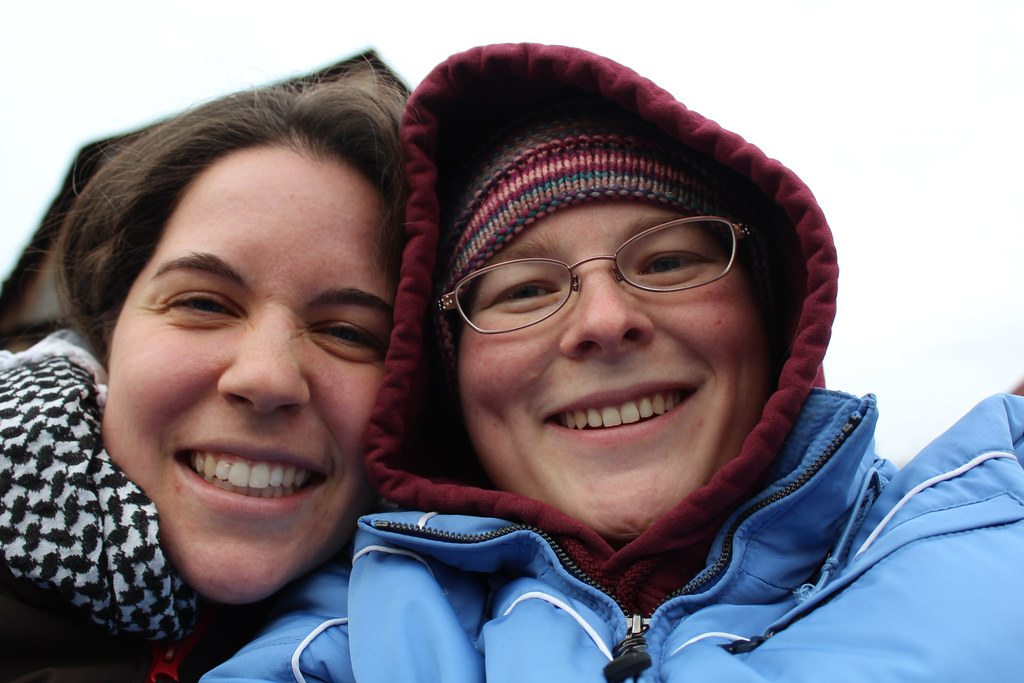 |
| Becca and I riding in the back of the Jeep |
Becca is amazing. She’s smart, articulate, and willing to challenge people and make the them think. So when I was trying to think of a bridesmaid gift for her, I wanted something was representative of our history, and something that was hand-crafted. Something that showed thought and intention as well as love. (As I’ve said before, there are few people who are knit/crochet-worthy for me, and fewer still who I’m willing to do other crafts for.)
I decided I was going to do some embroidery for her, of our old camp logo. Chimney Corners Camp and Becket Camp are a sister and brother camp in the Berkshires, and the camp where both Becca and I grew up. The camps both have lovely logos now, but the past logo was of a lake-scene, three paper-white-birches, a sailboat and pine trees. In a very simple sense, it was actually a scene you might see in part of camp, while hiking around the lake.
There are many older staff members who are very attached to the old logo (some even have tattoos of it!), so I knew it would be the perfect thing to embroider.
Originally I only planned to do the outlines of all the different elements, and then color the rest in with crayon and iron it. This method is how I normally do embroidery, as I have strong negative feelings toward working fill stitches. So I did that on the pillow, even ironed on the color so it looked nice, and then decided that the pillow really called for everything to be filled in with stitches… everything except the paper birches, which would remain the white of the pillow.
Well, I was working up to the Nth hour, and had to wrap the gift just before we left for the wedding. I told myself I’d get a picture of the pillow once Becca opened it… and promptly forgot.
But Becca is amazing, so she brought it to the farm for me to take a picture.
And in the joy of seeing friends, I forgot all about taking a picture of the pillow until she was leaving. She was patient enough to remind me as she packed herself out of the farm just as the daylight was making its way over the field.
 |
| Chimney Corners Camp Old Logo |
Isn’t it pretty?
This Christmas and New Years was spent at Michael’s family property, called “The Farm.” It’s a property about 45 minutes out of Charlottesville, VA, in the middle of practically nowhere. We were going to be there for ten days, so I knew I needed to pack strategically. You see, when at the Farm, there is no internet access, and no cell service. Reading material is limited to whatever someone else has left there. It’s a lovely place to spend holidays, because while there, it’s necessary to unplug and relax. The drawback? There isn’t really much to do, besides split wood and eat fruitcake. I knew I needed to strategize.
I needed to pack in a serious way – foresight and planning was needed. The last thing I wanted to do was finish working on a project and have nothing to start. The farm’s also rather drafty, so in addition to works in progress, I also needed some serious socks, hats and blankets. I packed nearly all of my hand-knitted socks, two of my favorite hats, a lap afghan (which also needed repairing) and a suitcase full of yarn. I also packed about a half-dozen knitting and crochet books and a couple of magazines, in case my hands got tired. Then, as a precaution, I also went on Webs and ordered some yarn I’d been meaning to pick up, to arrive at the farm. Just in case, by some mysterious event, I managed to finish everything else I had to work on.
This was a great plan. Over the next few days, I’m planning to share how my packing played out. So for the first story, the importance of staying warm while jeep cruising:
There are certain rituals that are observed at the farm. In the evening, one must pile into the antique jeep and take a tour of the property, surveying the field, stream and woods that make up the acreage. Even Michael’s 94 year old grandmother (with 2 hip replacements) manages to partake of the jeep ride.
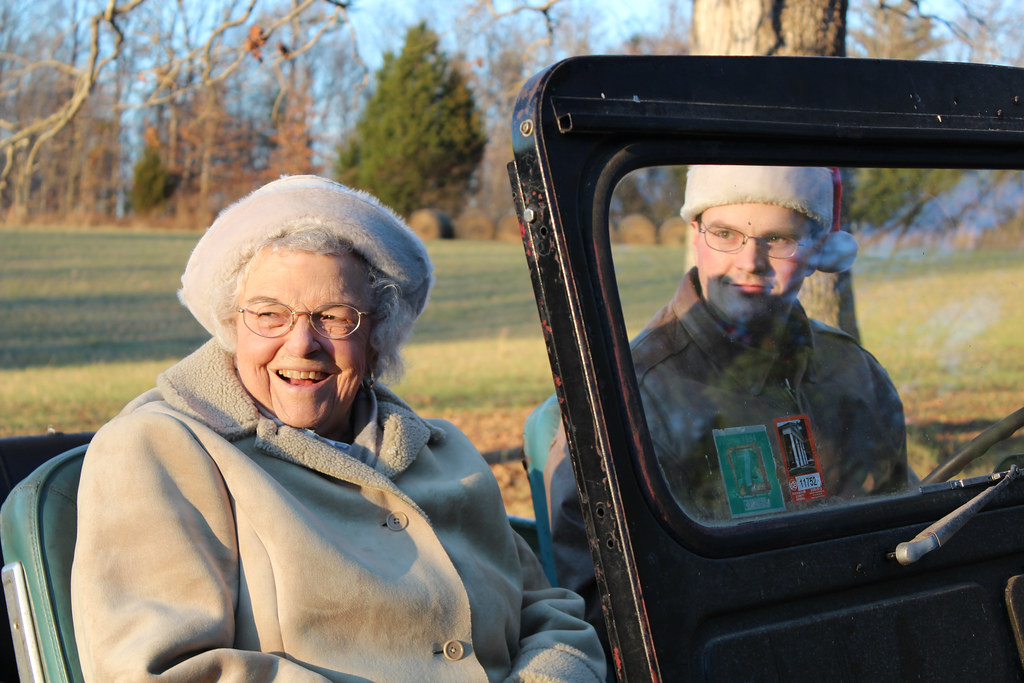 |
| Michael and his grandmother, known as Oma. |
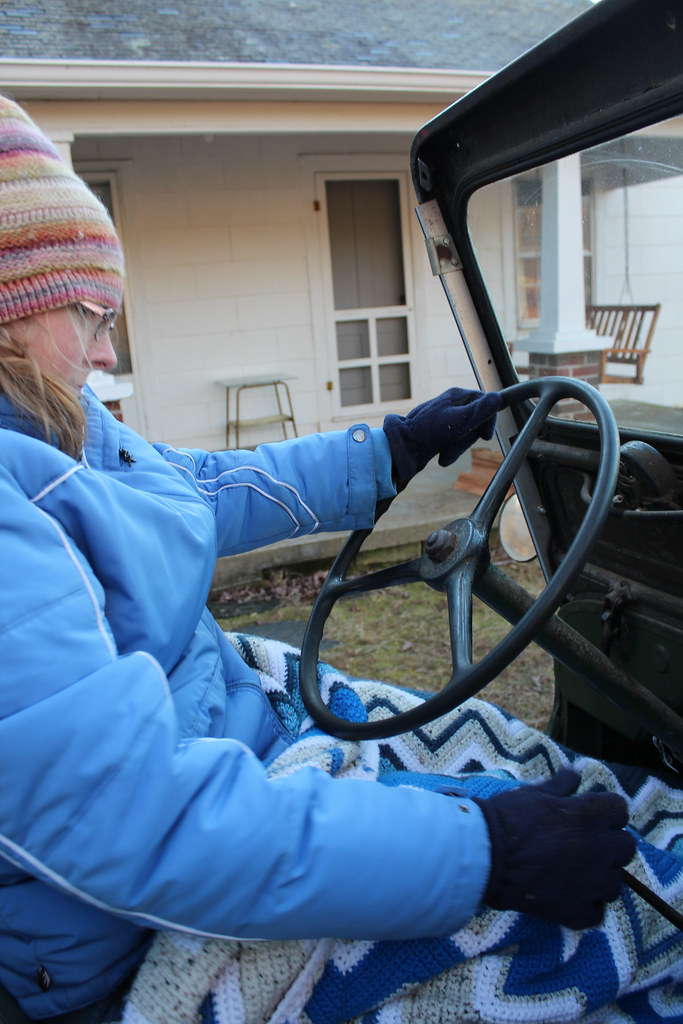 |
| The jeep needs force and concentration, when you are getting her started. |
 Michael and I headed up to PA two weekends ago to visit with my parents before Christmas. Among other things, I decided to drag my family to the nearest Local Yarn Store, mostly out of curiosity. Mountain Knits & Pearls has one of the best knitting store names I’ve ever come across (and a practically perfect sign to go with it). They’re located in East Stroudsburg, PA.
Michael and I headed up to PA two weekends ago to visit with my parents before Christmas. Among other things, I decided to drag my family to the nearest Local Yarn Store, mostly out of curiosity. Mountain Knits & Pearls has one of the best knitting store names I’ve ever come across (and a practically perfect sign to go with it). They’re located in East Stroudsburg, PA.
I had a hard time getting a good picture of the store without walking into the street, because I brought the wrong camera lens with me. But the store was easy to find and parking was plentiful (though that might have been for the impending snowstorm).
Inside the store was a welcoming sight of lots of yarn in beautiful wooden shelves. The walls, a light green color, went well with the overall look. Light was plentiful and a good bit of it was natural (a priority for me, so I can see if colors are true).

Perhaps the most delightful thing, for Michael at least, was the front window display, which had a toy train running around the tree.
One of the best parts of the store, at least for me, was their bead selection. You see, Knits and Pearls isn’t just a play on words. The store carries beads. Beautiful, beautiful beads. I had to practically hold myself back – as it’s always so hard for me to find beads in the same place where I’m selecting my yarns. I do love to put beads on my knitting.
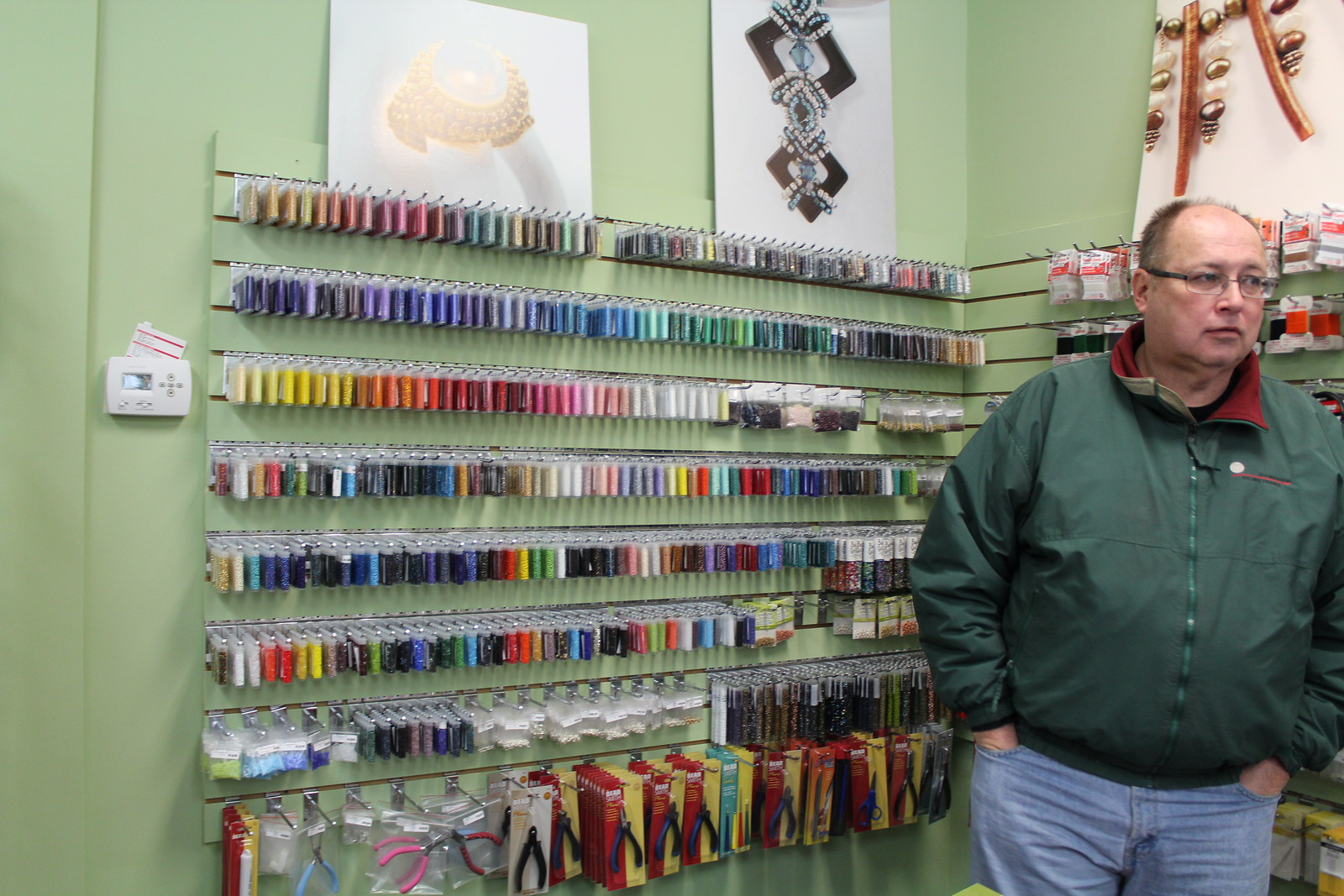 |
| My father, being more than patient. |
Now, in the interest of full disclosure, I must say I might have been a little biased in my evaluation of the store. You see, they were carrying the most recent issue of Interweave Crochet Accessories, which has my Plaited Hat pattern. It made me really happy to be able to show a copy to my father, who hadn’t seen the pattern yet.
Still, I’d say that Knits and Pearls had a great selection of magazines. If you are in the area, you should definitely check them out.
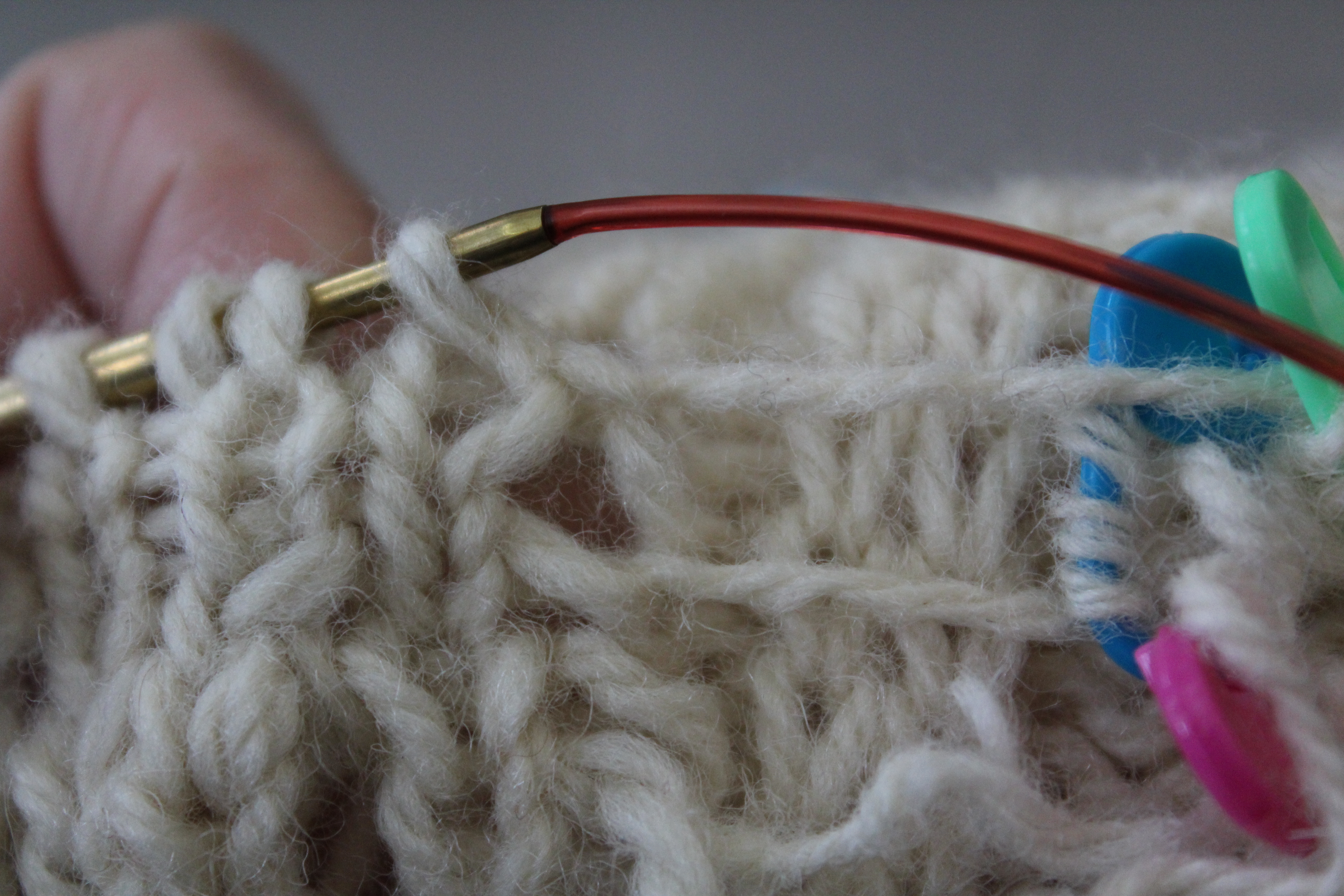 |
| working on repairs |
As you are putting away your holiday decorations, you notice it: a hole, a tear, a rip or an unraveled bit of yarn. Somewhere along the way this holiday season your childhood Christmas stocking, or that bit of lace your grandmother made, or other family heirloom has gotten a little beat up.
What do you do?
I’ve written before about checking your knit or crochet items to make sure they are staying well-cared-for, but what happens when the damage is already done? What do you do?
First, make sure that the stressors on the item have been removed. If the stocking was stuffed full of gifts, remove them. If the lace tablecloth was hanging off the side of the table, move it to a more supported location.
 |
| A recent Christmas Stocking Repair, nearly finished. I was fortunate to be able to closely match the red and the cream. |
Then, take a deep breath. Old knitted and crochet objects have a wonderful thing going for them: the stitches and yarn have been sitting in the same way for a very long time. They’ve settled and, perhaps in the case of wool, even felted a little bit. That means unless you are pulling and tugging on the object, the stitches should stay in place and unravel no further. If the yarn or fibers aren’t too delicate, fold the object up and put it in a bag that protects it from sun and dust. If it’s plastic, don’t seal the bag: it can trap moisture in with the fibers, which isn’t ideal.
Next, get on the phone or the internet and see if you can find a Local Yarn Store. If not, see if you can find a local museum or historical society that might deal with textiles. Often someone will know of someone who might have the skills to repair your object.
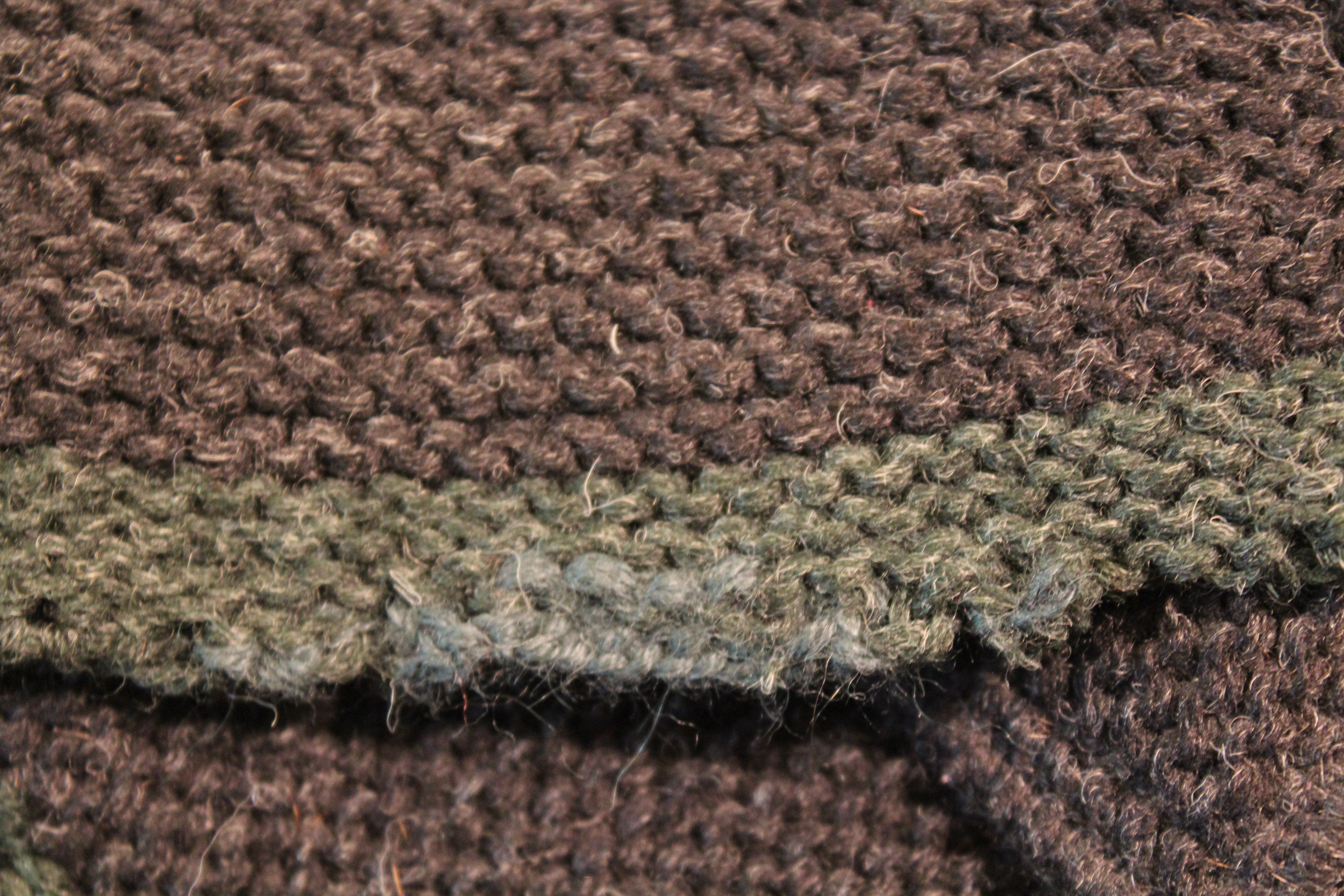 |
| Repairs to the edge of a sweater. |
Then, think. Before you talk to someone about repairing your heirloom
determine your goals. Are you looking to restore it to it’s former glory? Do you want to just have it fixed so you can continue using it? What is feasible for caring for your heirloom in the future?
A local knitter, crocheter or stitcher of some great experience might be skilled enough to repair holes and return your heirloom to former use, but they might not have the resources to do a perfect restoration. On the other hand, they might be more affordable. Meanwhile, someone affiliated with a museum might have more resources to do a full restoration of your heirloom, but it will probably cost more.
Making a decision about your commitment to keeping the heirloom safe and preventing it from deteriorating further is also important. If you plan to keep using the heirloom, it’s not feasible to have it under glass. Sometimes the best ways of preserving textiles is to not use them, which can be problematic if the reason you love a heirloom is because of it’s tradition of use.
 |
| Repairs to the arm of a person on a stocking – not all color matches can be perfect. |
Personally, I fall on the side of loving and using family heirlooms. I’m careful about how I handle and store them, but it doesn’t prevent me from using the object. As someone who creates, I think that useful objects (like furniture, clothing, blankets and many textiles) lose some of their meaning when they are no longer able to be used. And if the object takes some damage? Well, I’m fortunate enough to be able to make repairs myself.
I feel like it has been a sprint to the finish from the first week in November until now, but I can say with pleasure, as of the wee hours of today, I have all my deadlines finished until after the New Year. The finishing is done, the patterns are mailed off, presents are wrapped, Holiday cards are distributed, and I am officially very tired.
 |
| A collection of November and December Pictures |
In case you missed it the first time, the most popular posts from the last 2 months:
Tutorial: Mattress Stitch or Ladder Stitch
The Importance of Customer Relationship Management
Crochet Reinforcing for Steeking
Warning Signs Your Family Heirloom is Falling Apart
A Helpful Tool to Set in Sleeves
Over at Jordana Paige’s Blog:
The Low Down of Plies: What to Know when Choosing Yarn
What you need to know to set a Zipper in a Sweater
Tutorial: Re-sizing a Finished Sweater
Changing the Sleeve Silhouette on a Set in Sweater
Magic Sleeve Recipie
May you have a Happy Holiday!
 |
| Frostberry Hat, from one side. |
have some idea of what I’m after ie…a textured hat.
Then I just play around until I come up with something. Although sometimes I
have a stitch pattern I really like and want to use and I work from there, this
was how I came up with my Frostberry Hat pattern. Other times it is a yarn I have that I know I want to
use……. so it really depends on my starting point.
 |
| Frostberry Hat from the other side. |
 |
| Asperous Hat and Cowl |
but I also love Asperous Hat
and Cowl they both have lots of texture which
I love.
Be the first to learn about classes, patterns. upcoming events and more.